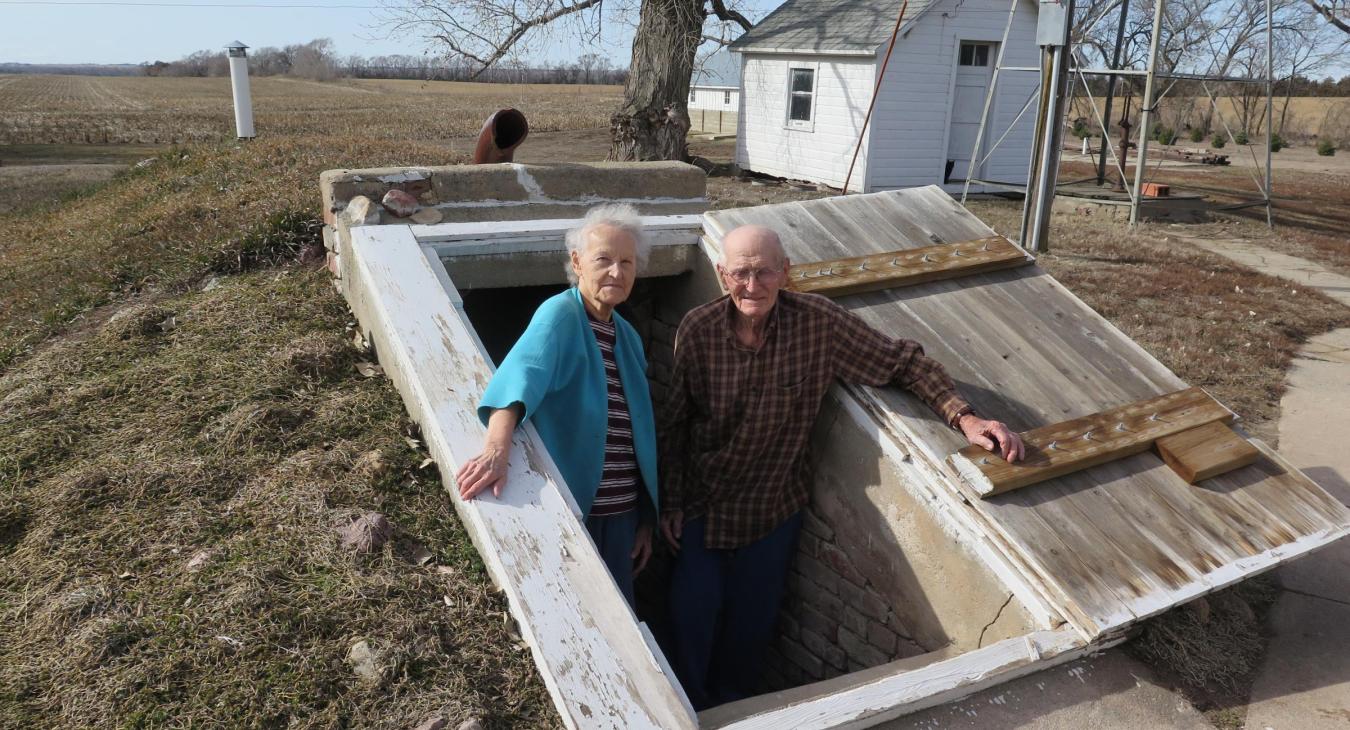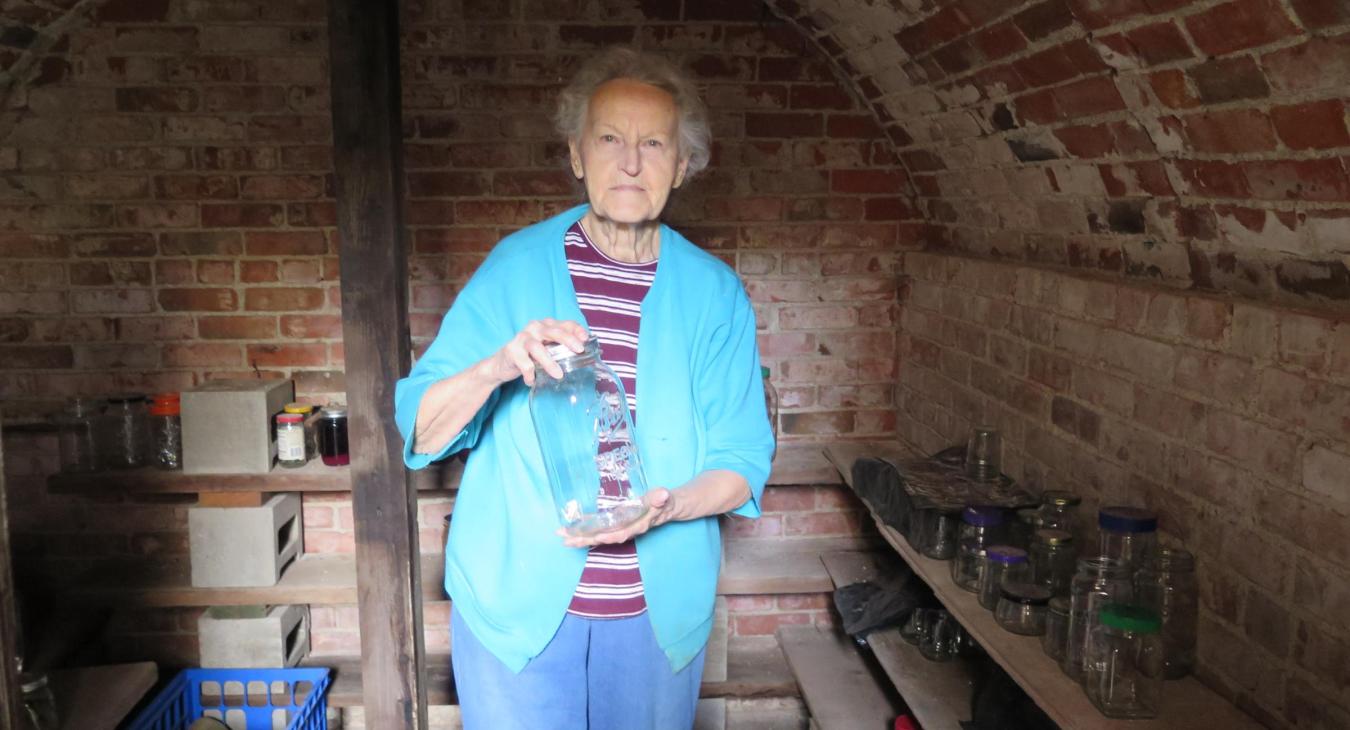By LaRayne Topp
Black and white images capture a still shot of life on the Nebraska plains in the 1880s. Custer County families tote out their prized possessions to be displayed forever on glass plate negatives—treadle sewing machines, songbirds in delicate cages, and even fancy pump organs—all for the purview of photographer Solomon Butcher.
In the background are prairie abodes: dugouts, sod shanties and even two-story frame houses. Beside the homes are necessary buildings. The outhouse, of course. A wash house where clothes are sorted, soaked and scrubbed. Various barns to house the chickens and milk cows, sheep and pigs
And then there’s the storm shelter. The farm cave. The fruit cellar. As necessary to survival in pioneer days as a home itself, storing food grown in the summer and gathered in the fall. A place of refuge when tornadoes twisted round the farmstead and fierce windstorms blew. A refrigeration center for eggs, cream and milk.
Before the time of rural electrification and modern refrigerators, a trip to the root cellar before each meal was as necessary as sunshine is to morning. Kids were sent there to fetch jars of home-canned applesauce, pork steaks layered under rendered lard in giant crocks, potatoes and carrots awaiting retrieval, and onions, dangling from the ceiling.
These root cellars or caves, as they were often called, kept farm-fresh produce from spoiling. Their underground location kept produce cooler in the summer than above ground, plus kept it from freezing throughout bitter cold winter months.
Some farm caves remain on viable farms today, but on abandoned farmsteads they are merely reminders of the value of their existence. It’s been so long since any have been constructed it’s difficult to find anyone who has actually built one.
Pilger, Nebraska, carpenter Leonard Raabe can only speculate how they may have been fashioned, but knows that Roman architecture, such as aqueducts and colosseums, often utilized arches. The curved design of these arches donated strength plus the ability to support a large weight placed at the top.
If he were to build a cave today, Raabe explained that he would dig out an area the size and depth he would want the finished cave to be. In the early days, horse-drawn slips or scrapers would have been used, with the operator walking behind while utilizing handles to steer. Raabe would then construct an arched wooden form on which to lay the brick or block. Once the bricks were set, he would remove the false works and shim, causing the arched bricks to settle down against each other, adding to their strength. Cement steps could then be added to an entrance down into the cave, with dirt shoveled over the top.
Some caves were actually dug into the hillside or tunneled into the ground as a gopher would in the compacted soil of clay farms. These caves, with wooden or cement steps and a bricked stairwell leading to the bottom, were used to store potatoes and other root crops.
Wesley Schutte of Beemer, Nebraska, especially remembers a cave built at the teacherage near his rural church. The cave was particularly deep, because as it was built and accessed from the home’s basement. At one time potatoes came in on railroad cars, sold for a premium price and stuffed into gunny sacks. They were carted into the teacherage basement and deeper still into the basement for storage. As the church’s trustee, Schutte was called when the basement water pipes burst and flooded the basement – and the water flowed on down into the cave.
“The potatoes got washed that day,” he said.
At the age of 97, Schutte never took advantage of a cave for shelter from an approaching storm.
“One time I looked out the window,” he said, but he never once went to the cave.
Melvin and Alma Meyer, of Pilger and in their early 90s, grew up with caves as youngsters and also utilize the cave at their current farm home. Just a few steps from their back door, the cave has provided refuge during windstorms and storage space for home-canned peaches, pickles and other produce.
The cave walls are fashioned from red brick, the interior is skim-coated with cement, and the steps to its cold depths are also of cement. A vent pipe out the top acts like a chimney, allowing the moisture from far below to escape into the atmosphere.
When Alma was a girl, her family’s cave was dug into the hillside. Her dad made shelves for her mother’s multitude of canning, and way in the back, her parents stored potatoes. Often, caves had a dirt floor space for those.
Because no home freezers were in use in homes when they were growing up, everything had to be canned: vegetables from the garden such as green beans, beets and cucumbers, fruit picked from farm orchards or purchased in town, and beef or pork butchered once or twice a year.
Each year, Alma’s family made sulc, pronounced sults, which is a canned meat of Czechoslovakian heritage.
“The Czechs didn’t butcher beef or pork for canning,” Alma said. “We’d sell it.” They raised chickens, ducks and geese and butchered them as needed before each meal, until they were able to rent lockers in town to store frozen meat and poultry.
Alma’s mother often canned food in large, glass half-gallon jars, stored on the cave’s ample shelving alongside pints of jelly.
“Mom bought fruit,” Alma said, but their strawberry bed was an acre in size.
“We’d stand on our head and pick strawberries all day, and then she’d give them away to the neighbors.”
Melvin remembers his mother standing over a hot stove, filling jars for her blue enamel, water bath canner. His family grew an orchard filled with fruit trees and grapevines which needed to be picked and preserved. They also canned beef.
“For five days of the week, from spring through fall, there was not a time she didn’t do a canner full of something,” he said.
At mealtime, trips were made before and after every meal to get milk along with canned fruit, vegetables or beef. Melvin was delighted the time his sisters came up from the cave screaming; bull snakes enjoyed the cool dark nature of the caves.
Growing up near Clarkson and Dodge, neither Alma nor Melvin recall many tornadoes during their childhood, but when they married and moved to Pilger, all that changed. They didn’t have a storm shelter or a basement as newlyweds, but their neighbors, George and Lena Chilcott, did, and invited the Meyers to retreat to their cave whenever they needed to, even if the Chilcotts weren’t at home.
Now Alma keeps a “tornado bag” packed with a flashlight, special photographs and jewelry, important papers, jugs of water, and two forks, two spoons and a can opener—for all the jars of food waiting to be enjoyed.
And two or three of her cats,” Melvin said with a smile.
When the Meyers’ grandkids were small, Melvin related how they’d peek into the dark recesses of the cave from the open door above. “I ain’t scared,” they’d say, but then would take his hand. “Would you go down with me?” they’d ask.
It’s a prized image of their farm cave they’ve captured, not on glass plate negatives, but in their hearts.


